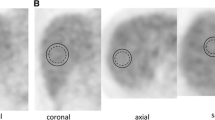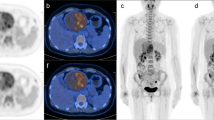Abstract
The signal-to-noise ratio in the liver (SNR liver) is commonly used to assess the quality of positron emission tomography (PET) images; however, it is weakly correlated with visual assessments. Conversely, the noise equivalent count (NEC) density showed a strong correlation with visual assessment but did not consider the effects of image reconstruction conditions. Therefore, we propose a new indicator, the modified SNR liver, and plan to verify its usefulness by comparing it with conventional indicators. We retrospectively analyzed 103 patients who underwent whole-body PET/computed tomography (CT). Approximately 60 min after the intravenous injection of 18F-fluorodeoxyglucose (FDG), the participants were scanned for 2 min/bed. The SNR liver and NEC density were calculated according to the Japanese guidelines for oncology FDG-PET/CT. The modified SNR live was calculated by multiplying the background-to-lung activity ratio by the SNR liver. Patients were classified into groups based on body mass index (BMI) and visual scores. Subsequently, the relationships between these physical indicators, BMI, and visual scores were evaluated. Although the relationship between the modified SNR liver and BMI was inferior to that of NEC density and BMI, the modified SNR liver distinguished the BMI groups more clearly than the conventional SNR liver. Additionally, the modified SNR liver distinguished low visual scores from high scores more accurately than the conventional SNR liver and NEC density. Whether the modified SNR liver is more suitable than the NEC density remains equivocal; however, the modified SNR liver may be superior to the conventional SNR liver for image-quality assessment.




Similar content being viewed by others
References
Fletcher JW, Djulbegovic B, Soares HP, Siegel BA, Lowe VJ, Lyman GH, et al. Recommendations on the use of 18F-FDG PET in oncology. J Nucl Med. 2008;49:480–508. https://doi.org/10.2967/jnumed.107.047787.
Deantonio L, Beldi D, Gambaro G, Loi G, Brambilla M, Inglese E, et al. FDG-PET/CT imaging for staging and radiotherapy treatment planning of head and neck carcinoma. Radiat Oncol. 2008;3:29. https://doi.org/10.1186/1748-717X-3-29. (Epub 20080918).
Fukukita H, Suzuki K, Matsumoto K, Terauchi T, Daisaki H, Ikari Y, et al. Japanese guideline for the oncology FDG-PET/CT data acquisition protocol: synopsis of Version 2.0. Ann Nucl Med. 2014;28:693–705. https://doi.org/10.1007/s12149-014-0849-2.
Mizuta T, Senda M, Okamura T, Kitamura K, Inaoka Y, Takahashi M, et al. NEC density and liver ROI S/N ratio for image quality control of whole-body FDG-PET scans: comparison with visual assessment. Mol Imaging Biol. 2009;11:480–6. https://doi.org/10.1007/s11307-009-0214-3. (Epub 20090328).
Amakusa S, Matsuoka K, Kawano M, Hasegawa K, Ouchida M, Date A, et al. Influence of region-of-interest determination on measurement of signal-to-noise ratio in liver on PET images. Ann Nucl Med. 2018;32:1–6. https://doi.org/10.1007/s12149-017-1215-y.
Shimada N, Daisaki H, Murano T, Terauchi T, Shinohara H, Moriyama N. Optimization of the scan time is based on the physical index in FDG-PET/CT. Nihon Hoshasen Gijutsu Gakkai Zasshi. 2011;67:1259–66. https://doi.org/10.6009/jjrt.67.1259.
Kamimura K, Nagamachi S, Wakamatsu H, Higashi R, Ogita M, Ueno S, et al. Associations between liver (18)F fluoro-2-deoxy-D-glucose accumulation and various clinical parameters in a Japanese population: influence of the metabolic syndrome. Ann Nucl Med. 2010;24:157–61. https://doi.org/10.1007/s12149-009-0338-1.
De Ponti E, Morzenti S, Guerra L, Pasquali C, Arosio M, Bettinardi V, et al. Performance measurements for the PET/CT discovery-600 using NEMA NU 2–2007 standards. Med Phys. 2011;38:968–74. https://doi.org/10.1118/1.3544655.
Brasse D, Kinahan PE, Lartizien C, Comtat C, Casey M, Michel C. Correction methods for random coincidences in fully 3D whole-body PET: impact on data and image quality. J Nucl Med. 2005;46:859–67.
Halpern BS, Dahlbom M, Auerbach MA, Schiepers C, Fueger BJ, Weber WA, et al. Optimizing imaging protocols for overweight and obese patients: a lutetium orthosilicate PET/CT study. J Nucl Med. 2005;46:603–7.
Farsad M. FDG PET/CT in the staging of lung cancer. Curr Radiopharm. 2020;13:195–203.
Capitanio S, Nordin AJ, Noraini AR, Rossetti C. PET/CT in nononcological lung diseases: current applications and future perspectives. Eur Respir Rev. 2016;25:247–58.
Kangai Y, Onishi H. Acquisition time optimization of positron emission tomography studies by use of a regression function derived from torso cross-sections and noise-equivalent counts. Radiol Phys Technol. 2016;9:161–9. https://doi.org/10.1007/s12194-016-0345-6.
Sonni I, Baratto L, Park S, Hatami N, Srinivas S, Davidzon G, et al. Initial experience with a SiPM-based PET/CT scanner: influence of acquisition time on image quality. EJNMMI Phys. 2018;5:9. https://doi.org/10.1186/s40658-018-0207-x.
Tsujikawa T, Oikawa H, Tasaki T, Hosono N, Tsuyoshi H, Rahman MGM, et al. Integrated [(18)F]FDG PET/MRI demonstrates the iron-related bone-marrow physiology. Sci Rep. 2020;10:13878. https://doi.org/10.1038/s41598-020-70854-w.
Inoue K, Goto R, Okada K, Kinomura S, Fukuda H. A bone marrow F-18 FDG uptake exceeding the liver uptake may indicate bone marrow hyperactivity. Ann Nucl Med. 2009;23:643–9. https://doi.org/10.1007/s12149-009-0286-9.
Vandenberghe S, Mikhaylova E, D’Hoe E, Mollet P, Karp JS. Recent developments in time-of-flight PET. EJNMMI Phys. 2016;3:3. https://doi.org/10.1186/s40658-016-0138-3.
Acknowledgements
We appreciate the cooperation of technologists Akihiro Horita and Shota Tachiura at the Public Central Hospital of Matto Ishikawa.
Author information
Authors and Affiliations
Contributions
SY designed this study. SY and HY performed material preparation and data collection. SY, KO, TN, and TY performed data analysis. All authors contributed to the data interpretation. The first draft of the manuscript was written by SY, and all the authors commented on the previous versions of the manuscript. All authors have read and approved the final manuscript.
Corresponding author
Ethics declarations
Conflict of interest
The authors have no relevant financial or nonfinancial interests to disclose.
Ethical approval
This study was approved by the Institutional Review Board of Public Central Hospital of Matto Ishikawa.
Consent to participate
All participants provided written informed consent.
Additional information
Publisher's Note
Springer Nature remains neutral with regard to jurisdictional claims in published maps and institutional affiliations.
Supplementary Information
Below is the link to the electronic supplementary material.
About this article
Cite this article
Yamashita, S., Okuda, K., Nakaichi, T. et al. Modified signal-to-noise ratio in the liver using the background-to-lung activity ratio to assess image quality of whole-body 18F-fluorodeoxyglucose positron emission tomography. Radiol Phys Technol 16, 94–101 (2023). https://doi.org/10.1007/s12194-023-00700-x
Received:
Revised:
Accepted:
Published:
Issue Date:
DOI: https://doi.org/10.1007/s12194-023-00700-x




